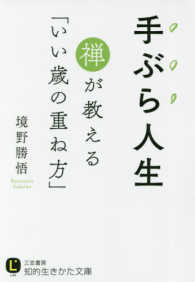Full Description
"The Marrakesh Treaty to Facilitate Access to Published Works for Persons Who Are Blind, Visually Impaired, or Otherwise Print Disabled" is a watershed development in the fields of intellectual property and human rights. As the first international legal instrument to establish mandatory exceptions to copyright, the Marrakesh Treaty uses the legal and policy tools of copyright to advance human rights. The World Blind Union Guide to the Marrakesh Treaty offers a comprehensive framework for interpreting the Treaty in ways that enhance the ability of print-disabled individuals to create, read, and share books and cultural materials in accessible formats. The Guide also provides specific recommendations to government officials, policymakers, and disability rights organizations involved with implementing the Treaty's provisions in national law.
Contents
Acknowledgments
Foreword
Executive Summary
Introduction
1. Guiding Principles for the Marrakesh Treaty
1.1. The Marrakesh Treaty at the Crossroads of Human Rights and Intellectual Property
1.1.1. The International Human Rights Regime
1.1.2. The International Intellectual Property Regime
1.1.3. Conflict or Coexistence Between the Regimes?
1.1.4. Using Copyright Tools to Achieve Human Rights Ends
1.2. Interpretive Principles for the Marrakesh Treaty
1.2.1. Emphasize Object and Purpose
1.2.2. Adapt the Marrakesh Treaty to Changing Conditions
1.2.3. Promote Consistency with the CRPD
1.2.3.1 Background to the CRPD
1.2.3.2. Central Principles of the CRPD
1.2.3.3. Consultations with Stakeholders
2. The Legal and Policy Choices in the Marrakesh Treaty
2.1. Copyrighted Works Covered by the Marrakesh Treaty
2.2. Accessible Format Copy
2.3. Authorized Entities
2.3.1. Introduction and Overview
2.3.2. Types of Authorized Entities
2.3.2.1. Entities Providing Services to Beneficiaries
2.3.2.2. Government Recognized Entities
2.3.3. The Practices of Authorized Entities
2.4. Beneficiary Persons
2.4.1. Introduction and Overview
2.4.2. Categories of Beneficiary Persons
2.4.2.1. Blindness
2.4.2.2. Visual Impairment or Perceptual Disability
2.4.2.3. Physical Reading Disability
2.4.3. Defining Beneficiary Persons in Implementing Legislation
2.5. Exceptions and Limitations to Copyright in National Law
2.5.1. Introduction and Overview
2.5.2. Obligations of Article 4(1)
2.5.2.1. Mandatory Exceptions and Limitations
2.5.2.2. Non-Mandatory Exceptions and Limitations
2.5.3. Modes of Implementing Article 4(1)
2.5.3.1. Article 4(2) - The Safe Harbor Option
2.5.3.1.1. The Safe Harbor for Authorized Entities
2.5.3.1.2. The Safe Harbor for Beneficiary Persons
2.5.3.1.3. Implications of the Safe Harbor Options
2.5.3.2. Article 4(3) - The Sui Generis Option
2.5.4. E&Ls for the Translation of Copyrighted Works
2.5.5. The Commercial Availability Option
2.5.6. The Remuneration Option
2.6. Cross-Border Exchange and Importation of Accessible Format Copies
2.6.1. Introduction and Overview
2.6.2. Substantive Obligations of Articles 5 and 6
2.6.2.1. Article 5 - Export of Accessible Format Copies
2.6.2.2. Article 6 - Import of Accessible Format Copies
2.6.3. Modes of Implementation of Articles 5 and 6
2.6.3.1. Article 5(2) - The Safe Harbor Option
2.6.3.1. Article 5(3) - The Sui Generis Option
2.6.4. Exhaustion of Rights
2.6.5. Implementation of Article 6
2.6.6. Cross-Border Issues Not Addressed in the Marrakesh Treaty
2.7.. Technological Protection Measures
2.7.1. Introduction and Overview
2.7.2. Analysis
2.8.. Three-Step Test
2.8.1. Policy Rationales of the Three-Step Test
2.8.2. The Three-Step Test and E&Ls for the Blind
2.8.3. Applying the Three-Step Test to the Marrakesh Treaty
2.8.4. The Three-Step Test and International Human Rights Law
3. Putting the Marrakesh Treaty Into Practice in National Law
3.1. Create Legal Remedies
3.2. Empower National Institutions
3.2.1. Human Rights Institutions
3.2.2. Intellectual Property Institutions
3.2.3. Linking to the Marrakesh Treaty Assembly
3.3. Undertake Enforcement Activities
3.3.1. Monitor Rights
3.3.2. Enforce Legal Remedies
3.3.3. Create a National Plan of Action
3.3.4. Engage in Training and Outreach
3.4. Engage in National Reporting
3.4.1. UN Treaty Bodies
3.4.2. UN Charter Bodies
3.4.3. UN Special Procedures
Conclusion
Appendices
World Intellectual Property Organization, Extraordinary General Assembly: A Decision Text, December 18, 2012
Marrakesh Treaty to Facilitate Access to Published Works for Persons Who Are Blind, Visually Impaired, or Otherwise Print Disabled (adopted on June 27, 2013, entered into force on September 30, 2016)
Signatories and Contracting Parties to the Marrakesh Treaty (as of October 31, 2016)
Convention on the Rights of Persons with Disabilities (CRPD) and Optional Protocol to the CRPD (adopted on December 13, 2006, entered into force on May 3, 2008)
Signatories and Contracting Parties to the Convention on the Rights of Persons with Disabilities (as of October 31, 2016)
Berne Convention for the Protection of Literary and Artistic Works, last revised at Stockholm, July 14, 1967 (without Appendix)
Index




